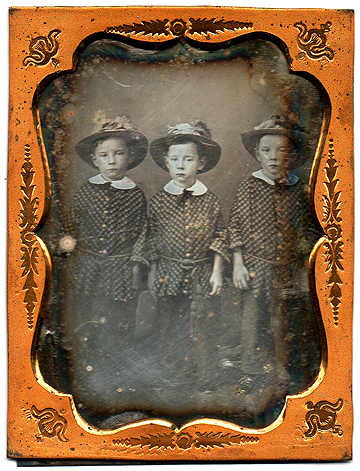Sign up for the Family Tree Newsletter Plus, you’ll receive our 10 Essential Genealogy Research Forms PDF as a special thank you!
Get Your Free Genealogy Forms
"*" indicates required fields
Multiple births aren’t uncommon today, but they were rarer in the 19th century. Four years ago I wrote about Judy Linnebach’s photo of an unidentified set of triplets. This week, it’s the adorable Ring brothers.
Image copyright: David Levy. Not to be used without permission
Meet Charles, Eleazer and Millard Ring! David Levy bought this lovely daguerreotype. A daguerreotype is an image on a highly reflective, silver-coated copper plate, a photographic method introduced to the United States in 1839. This image dates from the early 1850s.
A quick search of the 1860 census found the three 11-year-olds living with their mother, a sibling, and possibly their grandmother in Lubec, Washington County, Maine. Beside their names, the enumerator wrote “of one birth.”
A source for the Linnebach article, Anomalies and Curiosities of Medicine by George Milby Gould and Walter Lytle Pyle (published in 1904 and available on Google Books) states that most multiple births in the 19th century were to women in the age range of 30 to 34, and heredity was a factor.
Their mother Margaret gave birth to her daughter Lucy at age 23, and then two years later in 1849, to the boys. The Rings weren’t the only multiple birth in town: Just a page earlier in the census, Job and Almira Goodwin had a set of fraternal twins, Otis and Emily.
Charles, Eleazer and Millard were obviously doted upon by their mother. The identical tunics and broad-brimmed, decorated hats in this photo attest to that. Because of the fancy hats, David initially believed he’d bought an image of three girls.
Little boys in this period typically wore caps or broad-brimmed hats with wide hat bands. In this case, what looks like flowers could be a cluster of feathers—not an unusual hat decoration for a set of very well-dressed boys. The photo studio enhanced their buttons with gold paint.
Lubec, the easternmost town in the United States, sits on the border of Maine and New Brunswick. In the 1850s, it was an economically stable community of farmers and fishermen. According to Wikipedia, in 1859, the town had a tannery, a gristmill and nine sawmills. While I didn’t see a photographer listed in the 1860 census for the town, it’s possible that this thriving town had a daguerreotypist in 1850s.
Thank you to David for pointing out that another daguerreotype of the Ring triplets is at the Museum of Fine Arts in Boston, MA. You can view it here.
Solve your family photo mysteries with these books by Maureen A. Taylor:
ADVERTISEMENT






